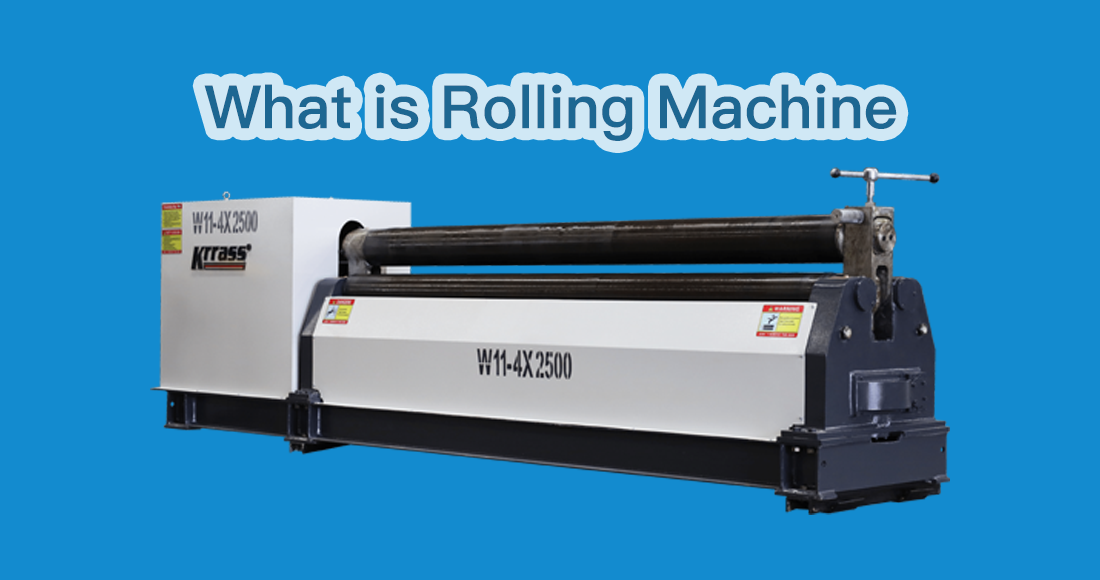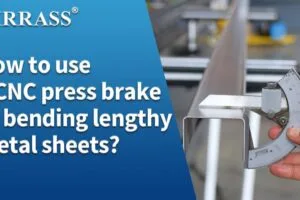In the realm of manufacturing excellence, the choice of the right rolling machine is paramount. Whether you're in the metalworking, construction, or automotive industry, selecting a reliable rolling machine manufacturer can make all the difference. Join us on this journey as we explore the key considerations for making this crucial decision. Discover the factors that define the ideal rolling machine manufacturer, ensuring precision, quality, and efficiency in your operations.
- Definition of a Rolling Machine
- Basic Mechanism of Rolling Machines
- Components of Rolling Machines
- Types of Rolling Machine
- Varieties of Rolling Machines
- Operational Process of Rolling Machines
- Application Domains of Rolling Machines
- How to Choose a Right Rolling Machine
- How to Choose a Rolling Machine Manufacturer
1. What is a Rolling Machine
A rolling machine is a piece of manufacturing equipment that contains two or more rollers. The rollers compress raw metal into a thinner and more uniform shape. This is essential when producing sheet metal.
A plate rolling machine is a type of rolling machine that can roll different kinds of sheet metal into a round or conical shape. It can also bend flat sheet metal into a large arc or cylinder, or even a square.
Plate rolling machines are used in many industries and the demand is always rising. They can bend stainless steel and basic steel, as well as aluminum, copper, and zinc. They can also be used to flatten, temper, or reduce gauge of material.
Plate rolling machines work by using hydraulic or mechanical power along with three to four hardened metal rollers. Normally, there is four rollers total, two of which are adjustable for size and cylinder shape.
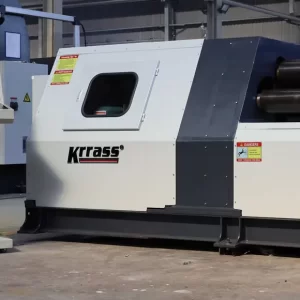
2. Basic Mechanism of Rolling Machines
In this chapter, we will delve into the fundamental mechanisms that underpin the operation of rolling machines. Understanding these principles is essential for comprehending how these machines transform raw materials into usable forms.
Principles of Metal Deformation
The core principle behind the operation of rolling machines is metal deformation. Metal deformation refers to the process of changing the shape and dimensions of a metal workpiece through the application of force. Rolling machines utilize controlled deformation to achieve specific outcomes. Here are key aspects of this principle:
Compression: Rolling machines exert compressive force on the metal workpiece. This force is applied by the rollers, causing the material to undergo compression. As a result, the thickness of the material is reduced, and its dimensions are altered.
Reduction in Thickness: One of the primary objectives of metal deformation in rolling is to reduce the thickness of the material. This is particularly crucial in industries where thin sheets or profiles are required, such as in the production of automotive body panels or sheet metal components.
Uniformity: Rolling machines are designed to provide uniform deformation across the entire length and width of the workpiece. This ensures that the final product meets stringent tolerances and maintains consistent quality.
Workpiece Temperature: Depending on the type of rolling (hot or cold), the workpiece's temperature plays a vital role. Hot rolling involves working with metal at elevated temperatures, making it more malleable, while cold rolling is performed at room temperature.
Role of Rollers
Rollers are the heart of any rolling machine. They are responsible for applying the necessary force and shaping the metal workpiece. The design and configuration of rollers are highly specialized, tailored to the specific type of rolling machine and its intended application. Here are key considerations regarding the role of rollers:
Configuration: Rolling machines can have various roller configurations, such as two-roll, three-roll, or four-roll designs. Each configuration serves different purposes and is chosen based on the desired outcome.
Pressure Application: Rollers apply pressure to the workpiece, ensuring that it undergoes the desired deformation. The pressure is carefully controlled to achieve the required thickness reduction and shape changes.
Roller Materials: Rollers are typically made from materials that can withstand high pressures and temperatures. Common materials include hardened steel or alloy materials known for their durability.
Adjustability: Some rolling machines have adjustable rollers that allow for precise control over the deformation process. This adjustability is critical for achieving the desired results and meeting specific manufacturing requirements.
Roller Alignment: Proper alignment of rollers is crucial to ensure uniform deformation. Misaligned rollers can lead to inconsistencies in the final product, impacting product quality and tolerances.
Understanding the principles of metal deformation and the role of rollers is fundamental to grasp how rolling machines operate. In the subsequent chapters, we will explore the specific types of rolling machines and their applications, shedding further light on the diverse world of rolling technology in manufacturing.
3. Components of Rolling Machines
In this chapter, we will dissect the key components that make up rolling machines, shedding light on their individual functions and contributions to the overall functionality of these indispensable industrial devices.
Rollers
Rollers are the heart and soul of a rolling machine. They play a central role in the deformation of metal workpieces and are responsible for shaping and transforming raw materials into the desired forms. Here's a closer look at the significance of rollers in rolling machines:
Pressure Application: Rollers are designed to apply controlled pressure to the metal workpiece. This pressure is what induces deformation, resulting in changes in thickness and shape. Rollers ensure that the force applied is uniform across the entire surface of the workpiece.
Roller Types: Rolling machines employ various types of rollers, depending on the specific application. These include top rollers, bottom rollers, and side rollers. The choice of roller type depends on the desired outcome and the complexity of the workpiece.
Material Selection: Rollers are typically constructed from durable materials capable of withstanding the significant pressures and stresses encountered during the rolling process. Common materials include hardened steel or specialized alloys known for their robustness.
Roller Configuration: The configuration of rollers can vary, with two-roll, three-roll, or four-roll designs being common. Each configuration offers distinct advantages and is chosen based on the requirements of the manufacturing process.
Frame
The frame of a rolling machine serves as its structural backbone, providing stability and support for the entire system. Here are the critical aspects of the frame's role:
Structural Integrity: The frame is constructed to withstand the substantial forces generated during the rolling process. It must be sturdy and rigid to maintain the precision and alignment of the rollers.
Alignment: Proper alignment of the frame is crucial to ensure that the rollers maintain their positions and orientations accurately. Misalignment can result in product defects and reduced quality.
Material Selection: Frames are typically made from high-strength materials, such as steel or cast iron, to ensure durability and longevity. The choice of material depends on the size and capacity of the rolling machine.
Drive System
The drive system is the power source behind the rolling machine, providing the necessary energy to operate the rollers and control the deformation process. Here's an overview of the drive system's functions:
Power Transmission: The drive system is responsible for transmitting power from the energy source (e.g., electric motor, hydraulic system, or mechanical drive) to the rollers. This power drives the rotation of the rollers and the movement of the workpiece.
Control and Adjustability: Advanced rolling machines incorporate a sophisticated drive system that allows for precise control and adjustability. This is essential for achieving the desired deformation outcomes and meeting specific manufacturing requirements.
Safety Measures: The drive system often includes safety features to ensure the protection of both the machine operators and the equipment. These features may include emergency stop mechanisms and safety interlocks.
Understanding the roles of rollers, frames, and the drive system in rolling machines is pivotal for grasping the mechanics of these versatile industrial tools. In the subsequent chapters, we will explore the operational dynamics and applications of different types of rolling machines, further deepening our knowledge of this essential technology in the realm of manufacturing.
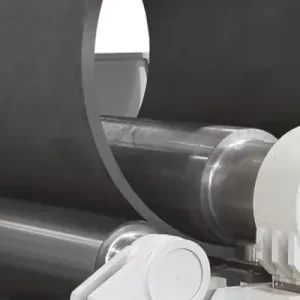
4. Types of Rolling Machines
Rolling machines come in various types, each tailored to specific manufacturing processes and materials. In this chapter, we will explore two primary categories of rolling machines: cold rolling and hot rolling, highlighting their unique characteristics and applications.
4.1. Cold Rolling
Cold rolling is a precision-oriented process that involves the deformation of metal workpieces at or near room temperature. This method offers several advantages and is commonly employed in various industries:
Key Characteristics of Cold Rolling:
Improved Surface Finish: Cold rolling is known for producing superior surface finishes on metal products. The process refines the workpiece's surface, resulting in a smoother and more aesthetically pleasing appearance.
Dimensional Accuracy: Cold rolling allows for precise control over dimensional accuracy. Manufacturers can achieve tight tolerances, making it ideal for producing components with stringent size requirements.
Work Hardening: Cold rolling leads to work hardening, which increases the material's strength and hardness. This is advantageous for applications requiring enhanced mechanical properties.
Reduced Thickness: Cold rolling is often used to reduce the thickness of metal sheets or strips while maintaining excellent uniformity throughout the workpiece.
Applications of Cold Rolling:
Sheet Metal Production: Cold rolling is commonly employed to produce thin, high-quality sheet metal used in various applications, including automotive body panels and appliance casings.
Precision Components: Industries requiring precision components, such as aerospace and electronics, benefit from cold-rolled materials for their dimensional accuracy and fine surface finish.
Surface Finish Enhancement: Cold rolling is used to improve the surface finish of products like stainless steel, ensuring a mirror-like appearance.
4.2. Hot Rolling
Hot rolling is a manufacturing process that involves working with metal at elevated temperatures. This method offers distinct advantages, making it suitable for specific applications across diverse industries:
Key Characteristics of Hot Rolling:
Enhanced Malleability: Hot rolling makes metals more malleable due to the elevated temperatures. This results in the material being more receptive to deformation.
High Production Rates: Hot rolling processes are typically faster than cold rolling, making them suitable for high-volume production scenarios.
Reduced Energy Consumption: Hot rolling requires less energy than cold rolling since the material is easier to deform at higher temperatures.
Initial Shape Transformation: Hot rolling is often used to convert large ingots or billets into more manageable shapes before further processing.
Applications of Hot Rolling
Structural Steel: Hot rolling is extensively used in the production of structural steel beams, bars, and sections for construction and infrastructure projects.
Railroad Tracks: The production of railroad tracks and other heavy-duty components benefits from hot rolling due to the materials' enhanced malleability.
Pipe and Tube Manufacturing: Hot rolling is employed to create pipes and tubes used in various industries, including oil and gas, where the properties of hot-rolled materials are advantageous.
Both cold and hot rolling processes play pivotal roles in the manufacturing landscape, offering unique benefits for different applications. In the subsequent chapters, we will explore additional types of rolling machines and delve deeper into their respective functionalities and industrial significance.
5. Varieties of Rolling Machines
Sheet Rolling Machines
1. Specific Uses
Sheet rolling machines are engineered to handle thin sheets of metal, transforming them into various shapes and configurations. They find applications in:
Roofing Industry: Sheet rolling machines are essential in producing roofing materials, including corrugated sheets and roof panels, to meet the demands of the construction sector.
HVAC Manufacturing: In the HVAC industry, these machines are employed to fabricate ducts and ventilation components, ensuring precise and consistent dimensions.
2. Advantages and Limitations
Advantages:
High Precision: Sheet rolling machines offer precise control over sheet thickness and shape, contributing to the production of uniform and accurately sized products.
Cost-Efficiency: They are cost-effective for producing large quantities of standardized sheet metal products, making them ideal for mass production.
Limitations:
Limited Thickness Range: Sheet rolling machines are not suitable for processing thick metal plates due to their design limitations.
Specific Applications: They are best suited for industries requiring thin sheet metal components and may not be versatile for other types of rolling tasks.
Structural Shape Rolling Machines
1. Applications and Benefits
Structural shape rolling machines are specialized for shaping metal profiles and sections, and they offer several advantages:
Architectural and Construction: These machines play a crucial role in the construction industry for creating beams, columns, and other structural components.
Custom Fabrication: Structural shape rolling machines enable custom fabrication of complex shapes, meeting the unique requirements of architectural and industrial projects.
2. Operational Considerations
Roller Configurations: Depending on the complexity of the profile, these machines may use two, three, or four rollers. The choice of configuration depends on the desired outcome.
Alignment and Precision: Precise alignment of rollers is essential to ensure the accuracy and uniformity of the final product.
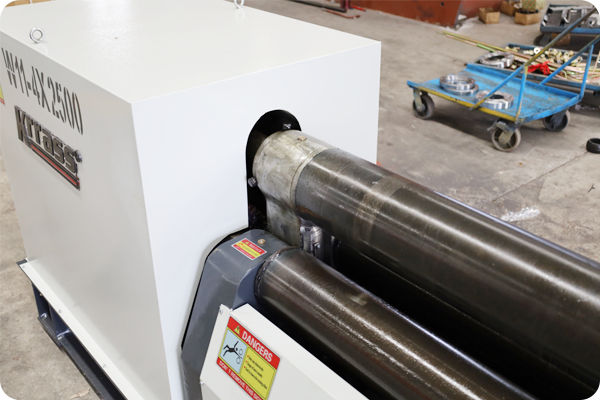
Plate Rolling Machines
1. Industrial Applications
Plate rolling machines are versatile and capable of handling a wide range of tasks, including:
Manufacturing Tanks and Pressure Vessels: These machines are employed in the production of cylindrical tanks and pressure vessels used in various industries.
Shipbuilding: Plate rolling machines play a critical role in the shipbuilding industry, shaping metal plates for hulls and other ship components.
2. Key Features
Variable Geometry Rolls: Plate rolling machines often feature variable geometry rolls that can be adjusted to accommodate different plate thicknesses and shapes.
High Capacity: They are designed to handle heavy-duty tasks, making them suitable for demanding industrial applications.
These varieties of rolling machines serve as indispensable tools in a multitude of industries, enabling the efficient production of a diverse range of metal products. In the subsequent chapters, we will further explore the operational intricacies, advancements, and emerging trends within the realm of rolling technology.
6. Operational Process of Rolling Machines
In this chapter, we will delve into the operational process of rolling machines, from the pre-operational setup to the rolling operation itself, and finally, the post-operational tasks that ensure the quality and longevity of both the product and the machine.
A. Pre-Operational Setup
1. Material Selection
Before the rolling process begins, careful consideration of the material is essential. The choice of material depends on the intended application and specific requirements. Factors to consider include material type, thickness, width, and metallurgical properties. Material selection is a critical step to ensure the desired outcome and product quality.
2. Machine Calibration
Machine calibration is crucial for achieving precision and accuracy during the rolling process. This step involves setting and fine-tuning various parameters, such as roller alignment, pressure settings, and speed controls, to match the material and product specifications. Calibration ensures that the machine is ready to produce consistent results.
B. Rolling Operation
1. Feeding the Material
The rolling operation begins with feeding the selected material into the rolling machine. Proper alignment and positioning of the material are essential to ensure even deformation and avoid misalignment issues. The material is gradually fed into the rollers, where the rolling process takes place.
2. Adjusting Rollers
Roller adjustment is a critical aspect of the rolling operation. Depending on the desired outcome and the material's properties, the rollers may need to be adjusted for pressure, gap, and position. Precise adjustments are necessary to control the thickness and shape of the material as it passes through the machine.
C. Post-Operational Tasks
1. Inspecting the Product
After the rolling process is complete, a thorough inspection of the product is essential. This inspection involves checking for defects, dimensional accuracy, surface finish, and overall quality. Any deviations from the specified requirements should be identified and addressed promptly.
2. Machine Maintenance
Regular machine maintenance is vital for ensuring the long-term functionality and reliability of rolling machines. Maintenance tasks include lubrication of moving parts, inspection of wear and tear, and replacement of worn components. Preventive maintenance helps prevent breakdowns and ensures the machine operates at peak efficiency.
Safety Considerations:
Throughout the entire operational process, safety precautions must be strictly observed. Operators should wear appropriate protective gear, and safety interlocks and emergency stop mechanisms should be in place. Training and adherence to safety protocols are paramount to minimize the risk of accidents.
The operational process of rolling machines combines precision, skill, and attention to detail. Effective pre-operational setup, meticulous rolling operations, and thorough post-operational tasks collectively contribute to the production of high-quality rolled products while ensuring the safety and longevity of the machinery.
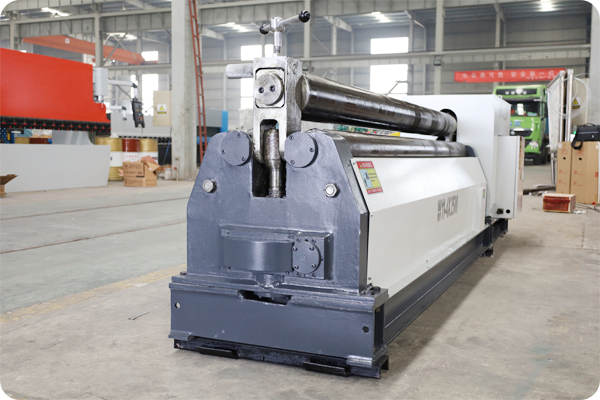
7. Application Domains of Rolling Machines
Rolling machines find widespread application across various industries due to their versatility and capability to transform raw materials into essential components. In this chapter, we will explore the primary domains where rolling machines play pivotal roles.
A. Metalworking Industries
1. Use in Forming Operations
Rolling machines are integral to metalworking industries, where they are extensively employed in forming operations. These operations encompass bending, shaping, and altering the dimensions of metal sheets, plates, and profiles. Rolling machines provide precise control over the deformation process, allowing manufacturers to create components with intricate shapes and tight tolerances.
2. Significance in Mass Production
In metalworking, rolling machines hold immense significance in mass production scenarios. They enable the efficient and cost-effective production of standardized metal components. The ability to process high volumes of workpieces in relatively short time frames contributes significantly to the overall productivity of metalworking industries.
B. Construction Industries
1. Role in Structural Development
Rolling machines play a vital role in the construction industry, particularly in structural development. They are used to shape and form various structural components, including beams, columns, and plates, which serve as the building blocks for large-scale construction projects. Rolling machines ensure that these components meet the required specifications, allowing for the construction of safe and durable structures.
2. Impact on Project Efficiency
The utilization of rolling machines in construction projects enhances project efficiency. Precisely manufactured structural components reduce the need for on-site modifications and adjustments, leading to smoother construction processes. This, in turn, contributes to reduced project timelines and cost savings.
C. Automotive Industries
1. Contribution to Vehicle Manufacturing
Rolling machines are a cornerstone of the automotive industry, facilitating the manufacturing of various vehicle components. They are used to create parts such as chassis frames, body panels, and engine components. Rolling machines ensure that these components meet strict quality standards and tolerances, contributing to the safety and performance of vehicles.
2. Advancement in Automotive Design
The automotive industry continually benefits from the advancement of rolling machine technology. Innovations in rolling techniques allow for the production of lightweight and high-strength materials, which are crucial for achieving fuel efficiency and improving vehicle safety. Rolling machines also enable the creation of complex and aerodynamic vehicle designs that enhance both aesthetics and performance.
8. How to Choose the Right Rolling Machine
Selecting the appropriate rolling machine is a critical decision that can significantly impact the success of your manufacturing or fabrication processes. To make an informed choice, consider the following factors when choosing the right rolling machine for your specific needs:
1. Application Requirements:
Begin by clearly defining the intended application and the types of materials you will be working with. Different rolling machines are designed for various purposes, such as plate rolling, profile rolling, or sheet rolling. Understanding your specific application requirements is essential to narrow down your options.
2. Material Specifications:
Take into account the characteristics of the materials you will be processing. Consider factors such as material type, thickness, width, and metallurgical properties. Some rolling machines are better suited for specific materials, so ensure that your chosen machine can handle the materials you intend to work with.
3. Capacity and Size:
Evaluate the size and capacity of the rolling machine. Ensure that it can accommodate the dimensions of your workpieces comfortably. Oversized or undersized machines can lead to inefficiencies and affect product quality.
4. Precision and Tolerance Requirements:
Determine the level of precision and tolerance your applications demand. If you require tight tolerances and high precision, opt for a rolling machine that offers fine adjustment controls and precise calibration features.
5. Roller Configuration:
Consider the roller configuration of the machine. Depending on your application, you may need a two-roll, three-roll, or four-roll design. The choice of configuration will impact the types of shapes and profiles you can achieve.
6. Automation and Control:
Modern rolling machines often come equipped with advanced automation and control systems. These features can enhance productivity and reduce human error. Evaluate whether automation features such as CNC (Computer Numerical Control) capabilities are necessary for your operations.
7. Safety Features:
Prioritize safety features when selecting a rolling machine. Look for machines that include safety interlocks, emergency stop mechanisms, and clear safety guidelines. Ensuring the safety of machine operators is paramount.
8. Maintenance and Serviceability:
Consider the ease of maintenance and the availability of service and support for the rolling machine. Regular maintenance is crucial for machine longevity and consistent performance.
9. Budget and Cost of Ownership:
Set a realistic budget that accounts not only for the initial purchase cost but also ongoing operating expenses and maintenance. Be mindful of the total cost of ownership, which includes maintenance, energy consumption, and potential downtime.
10. User Training and Support:
Evaluate the availability of training and support from the machine manufacturer or supplier. Proper training ensures that your operators can use the machine effectively and safely.
11. Reviews and Recommendations:
Seek feedback and recommendations from industry peers who have experience with similar rolling machines. Online reviews and testimonials can also provide valuable insights.
12. Future Expansion:
Consider your long-term needs and whether the rolling machine can accommodate potential future expansion or changes in your production requirements.

9. How to Choose a Rolling Machine Manufacturer
Selecting the right rolling machine manufacturer is crucial to ensure you receive a high-quality machine that meets your needs and expectations. Here are key steps to guide you in choosing the ideal manufacturer:
1. Define Your Requirements:
Before you start searching for a manufacturer, clearly define your requirements. Determine the type of rolling machine you need, its specifications, capacity, and any specific features or customizations you require. Having a well-defined set of requirements will help you narrow down your options.
2. Research and Shortlist Manufacturers:
Conduct thorough research to identify rolling machine manufacturers that specialize in the type of machine you need. Utilize online resources, industry directories, and trade publications to create a list of potential manufacturers.
3. Assess Experience and Reputation:
Look for manufacturers with a solid track record of producing high-quality rolling machines. Consider factors such as the number of years they've been in business, their reputation within the industry, and any certifications or awards they may have received.
4. Product Quality and Technology:
Evaluate the quality of the rolling machines they produce. Examine their technological capabilities and whether they incorporate the latest advancements in their machines. Quality should be a top priority to ensure the longevity and reliability of your investment.
5. Customer References and Reviews:
Seek customer references from the manufacturer and reach out to past clients to gather feedback on their experiences. Additionally, read online reviews and testimonials to gain insights into customer satisfaction and any potential issues.
6. Technical Support and Service:
Inquire about the manufacturer's technical support and after-sales service. A responsive and reliable support system is essential for addressing any issues that may arise during the machine's operation.
7. Customization Options:
If your project requires customized features or specifications, ensure that the manufacturer has the capability to accommodate your needs. Discuss your customization requirements with them to assess their flexibility.
8. Warranty and Maintenance:
Review the manufacturer's warranty policies and maintenance agreements. A comprehensive warranty can provide peace of mind, and understanding the terms of maintenance and servicing is crucial for long-term machine reliability.
9. Pricing and Budget:
Request detailed quotes from multiple manufacturers and compare their pricing. Be cautious of significantly lower prices, as they may indicate compromised quality. Consider your budget while also weighing the overall value of the machine.
10. Visit the Manufacturing Facility:
Whenever possible, visit the manufacturer's production facility. This allows you to inspect their manufacturing processes, quality control measures, and the working conditions of their staff. It also provides an opportunity to meet the team responsible for building your machine.
11. Sustainability and Environmental Practices:
In today's eco-conscious world, inquire about the manufacturer's sustainability practices and their commitment to environmental responsibility. Choosing a manufacturer that aligns with your environmental values may be important to your organization.
12. Communication and Responsiveness:
Assess the manufacturer's communication skills and responsiveness. Effective and open communication is crucial throughout the purchasing process and beyond.
13. Negotiate and Clarify Terms:
Once you've identified a preferred manufacturer, engage in negotiations and clarify all terms, including payment schedules, delivery timelines, and any special arrangements. Ensure that all agreements are documented in writing.
14. Seek Legal and Professional Advice:
Consider seeking legal and professional advice before finalizing any contracts or agreements with the manufacturer to protect your interests.
Conclusion
In your pursuit of the perfect rolling machine, remember that excellence knows no compromise. At Krrass, we stand proudly as your trusted partner in the world of rolling machines and beyond. With a legacy of innovation and a commitment to quality, we are your go-to source for top-notch machinery solutions. Explore our wide range of offerings and discover why we are a leading choice among rolling machine manufacturers. Join us today at Krrass and experience a world of precision engineering and manufacturing mastery.
